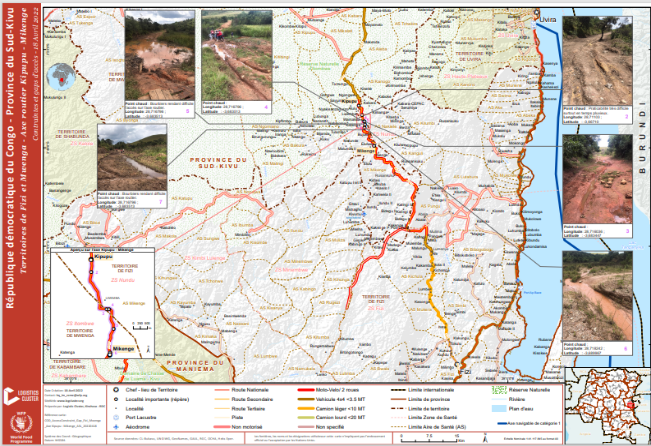Overview
In March 2022, the Institut National de la Statistique (INS) published its report, Rapport Global du Recensement General des Entreprises 2019 (available here) and reported a total of 586,587 registered companies with 1,286 from the transport & storage sectors (0,2%). The transport sector remains informal according to the Federation des Entreprises du Congo (FEC) and is estimated up to 92,8% by the INS. Transporters are mainly very small sized companies with mainly one to three trucks, although national truck companies with large modern fleets also operate near main cities and along mining road corridors.
Rate and Contracting
Transport costs are expensive compared to the neighboring countries. This is a result of the high number of taxes at both national and provincial levels, and additional and duplicated fees along the road. Rates are calculated based on the truck capacity (e.g. 5 mt, 10 mt), the distance and also the rainy season as this also impacts the price. Both parties have space to negotiate additional terms and conditions such as minimum lead time to book a truck, replacement in case of breakdown, cargo insurance etc. Furthermore, subcontracting is done by very small size companies to meet the customer’s capacity requirement and it’s recommended to clarify whether subcontracting is used prior to the contract signature.
Depending on the region, trucking companies have fleet adapted to the road conditions (paved vs off road). Mechanical condition, driver experience, fleet capacity and towing service in case of breakdown are key criteria to consider during the selection process, as well as the knowledge of the area of operations considering the highly volatile security situation in DRC. In general, goods are carried into a closed metallic container to secure the cargo and to protect it during the rainy season.
Road transport regulations
A trucking company must have a set of administrative documents to obtain an agreement from the Ministry of Transport and Communications and legally run its business at the national level. In 2022, below is the list of mandatory documents:
-
Company
|
Document |
Validity |
Issued By |
|---|---|---|
|
N° d’Identification National (IDNAT) |
n/a |
Ministère de l’Economie Nationale |
|
N° au Registre du Commerce et de Crédit Mobilier (RCCM) |
n/a |
Ministère du Commerce |
|
Le Numéro d’Impôt |
n/a |
Ministère des Finances |
|
L’Agrément de Transport |
One year |
Direction Générale des Recettes Administratives, Judiciaires, Domaniales et de Participations (DGRAD) |
|
L’attestation fiscale (NIF) |
6 months |
Direction Générale des Impôts (DGI) |
-
Truck
|
Document |
Validity |
Issued By |
|---|---|---|
|
Certificat du Contrôle Technique |
4 months |
Approved Mechanic Workshop |
|
Certificat d’immatriculation (carte rose) |
n/a |
Direction Générale des Impôts (DGI) |
|
Police d’assurance |
One year |
Insurance company |
-
Insurance
Local insurance contracted by trucking companies only covers the third-party liability, therefore cargo insurance is upon customer request. T o ensure a comprehensive and reliable service, the trucking company will subscribe an insurance from an international broker (Kenya, Uganda or Tanzania) at customer’s expense.
Organization & Structure of National Transporters
The Federation des Entreprises du Congo (FEC) is the main union, gathering all the transporters formally registered under the Congolese law. Organized under their Commission Nationale de Transport, the FEC is the main channel for dialogue and lobbying with the public and authorities at national and provincial levels, to escalate and share their concerns.
|
Commission Nationale |
Comités Professionnels |
|
Transport |
Comité Professionnel des Transporteurs Routiers |
|
Other |
Comité Professionnel des Transporteurs Aériens |
|
Comité Professionnel des Agences de Voyages |
|
|
Comité Professionnel des Agents Maritimes |
|
|
Comité Professionnel des Transporteurs Fluviaux & Lacustres |
In addition, private associations such as ASBL (Association Sans But Lucratif) exist with the same aim to escalate at provincial level any difficulties faced to perform their activities.
Domestic and humanitarian needs are covered by the national capacity of the market and challenges to meet both requirements were not observed during the past years. Even in case of a sudden increase of transportation needs by the humanitarian community, the available national market has been able to absorb an increase in demand.
However, external factors such as poor rood conditions, closed borders due to security situation, destroyed bridges, floodings or port congestion must be considered and might impact the access and the lead time. Therefore, contingency stock and replenishment must be prepared in advance to avoid any disturbance within the relief activities
Access constraints maps

The DRC Cluster Logistics offers a broad range of maps informing about road conditions and maximum ton capacity allowed.
For more information, please visit here the DRC Cluster Logistics website
For more information on transport company contact details, please see the following link:4.8 Transporter Contact List .
Disclaimer: Inclusion of company information in the LCA does not imply any business relationship between the supplier and WFP / Logistics Cluster, and is used solely as a determinant of services, and capacities.
Please note: WFP / Logistics Cluster maintain complete impartiality and are not in a position to endorse, comment on any company's suitability as a reputable service provider.


